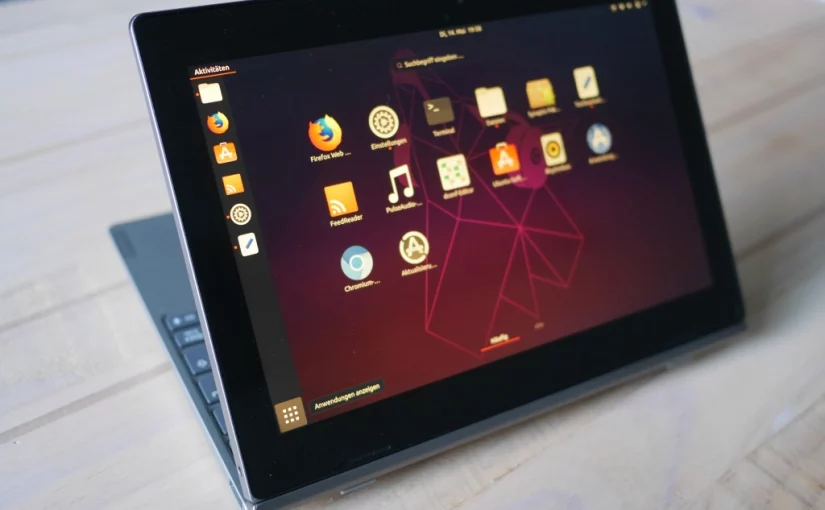The Lenovo D330 2-in-1 convertible (or netbook as we used to say) is a quite interesting device. It is based on Intels current low-power core platform, Gemini Lake (GLK), and thus offers great battery-life and a fan-less design.
This similar to what you would from an ARM based tablet. However being x86 based and Windows focused we can expect to get Ubuntu Linux running – without requiring any out-of-tree drivers or custom kernels that never get updated as we are used-to from the ARM world.
This post will be about my experiences on doing so.
For this I will use the most recent Ubuntu 19.04 release as it contains fractional scaling support, which is essential for a 10″ 1920x1200px device. Also the orientation sensor (mostly) works out of the box, when compared to the 18.04 LTS release.
Table of Contents
- Getting to the desktop
- Wrong screen orientation
- Touch input rotation
- Enabling fractional scaling
- What does not work
- What does work
- State of touch UI on Linux
Getting to the desktop
After booting the live USB, you will notice that the screen stays black. This is caused by the i915 driver not correctly setting up the internal (DSI) screen (see FDO#109267).
A quick workaround for this is to rotate the device, causes the i915 driver to re-initialise the screen, which will work at this point. Alternatively you can also suspend/ resume the device.
Wrong screen orientation
Once on the desktop, you will notice that it is rotated by 90° which is caused by a missing mount matrix entry in udev shipped with 19.04.
First we manually rotate the screen to landscape mode by opening a terminal via Ctrl+Alt+T and typing
xrandr -o rightNow we can continue to add the missing accelerometer mount matrix. Create the file /etc/udev/hwdb.d/61-sensor-local.hwdb with the following content:
# IdeaPad D330
sensor:modalias:acpi:BOSC0200*:dmi:*:svnLENOVO:pn81H3:*
ACCEL_MOUNT_MATRIX=0, 1, 0; -1, 0, 0; 0, 0, 1To immediately apply the changes do
sudo systemd-hwdb update
sudo udevadm trigger -v -p DEVNAME=/dev/iio:device0
sudo service iio-sensor-proxy restartTouch input rotation
Now you can rotate the device and the screen content will be correctly oriented. However, if you try to use the touchscreen, you will notice that it only behaves correctly in portrait mode.
This is caused by a bug in GNOME/ mutter introduced in the 3.32 release. It will be fixed in the 3.32.2 point-release. In the meantime you can use the updated mutter packages, where I have backported the fix.
Enabling fractional scaling
Finally we need to magnify the UI by 50% in order not to damage our eyes. Unfortunately the fractional scaling in Ubuntu 19.04 is hidden by default. To enable it enter the following in a console
gsettings set org.gnome.mutter experimental-features "['scale-monitor-framebuffer', 'x11-randr-fractional-scaling']"This will enable fractional scaling for both Wayland and Xorg sessions. Here, you will get a noticeable performance hit when using Xorg. However you should choose it regardless due to the following on Wayland
- legacy X11 application (like e.g. firefox) are just scaled up and thus appear blurry
- GNOME shell often just stops accepting any input and there is no way to restart it on Wayland
- due to some GNOME shell design flaws (#749) the mouse cursor appears sluggish as it is updated at a lower rate compared to Xorg
This probably also helps understanding why Xorg is still default on the majority of Linux distributions.
What does not work
Surprisingly little, actually. The only remaining issue is that you will lose sound after a suspend/ resume cycle due to some bug in snd-hda-intel-realtek.
What does work
- WiFi
- Front & back camera
- Docking & Undocking of the keyboard
- Touch screen & screen rotation
State of touch UI on Linux
However there is more than getting the hardware to start when using the device on a daily basis – you will also have to fight the linux apps. Currently only GTK3 apps have some understanding of touch events – most other toolkits need updating. To estimate the time until this will happen keep in mind that touch on Linux is a niche inside a niche.
Firefox for instance does not understand touch events and you will have to manually enable them as described here.
But even then you will be able to drag the window around – thanks to client side decoration (CSD) window placement is handled by Firefox itself, but it does not react to touch events #1530070 (same applies to Chrome btw).
Next all apps continue to launch in windowed mode. On device with limited screen space, you will soon notice why everything is full-screen on Android (and Windows Tablet Mode).
Finally the GNOME on-screen keyboard feels quite sluggish and lacks visual feedback. Therefore you will often end up with missing letters.
So in summary it is not a very pleasant experience right now.
Fortunately GNOME/ Ubuntu are supposedly on it for the next release.
Until then I would recommend sticking with Windows 10; fractional scaling just works there and you will really value its on-screen keyboard and tablet mode when having the physical keyboard detached.
